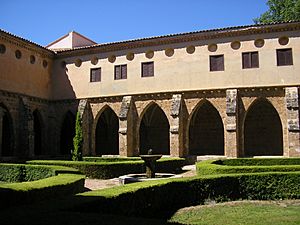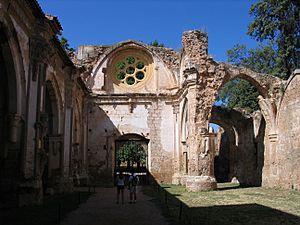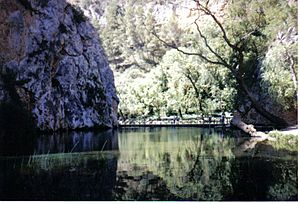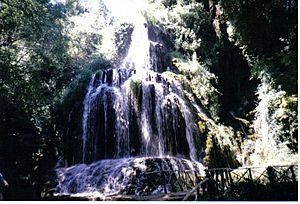Monasterio de Piedra facts for kids
Quick facts for kids Monasterio de Piedra |
|
|---|---|
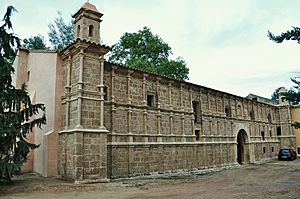 |
|
| Religion | |
| Affiliation | Cistercians |
| Province | Zaragoza |
| Year consecrated | 1218 |
| Location | |
| Location | Nuévalos, |
| Architecture | |
| Architectural style | Gothic and Baroque |
| Completed | 12th–18th centuries |
Monasterio de Piedra (which means Stone Monastery) is a special place in Spain. It's a mix of an old monastery, a hotel, and a beautiful park. You can find it in the Iberian System mountains, close to Nuévalos in the Province of Zaragoza, Aragon.
The monastery was started in 1194 by Alfonso II of Aragon. He brought thirteen Cistercian monks from another monastery called Poblet. They built it in an old castle right next to the Piedra River. The monastery was dedicated to St. Mary the White. On February 16, 1983, this whole complex became a national monument.
Contents
History of the Stone Monastery
The Monasterio de Piedra is next to the Piedra River. It's one of the most visited spots in Aragon. People love its many gardens and waterfalls. These were created by the river flowing through the Piedra Canyon. It's a great place for tourists to relax and have fun.
The Monasterio de Piedra is in a very dry part of Spain. Its story began in 1194. King Alfonso II of Aragon and his wife, Doña Sancha, gave an old Moorish castle to monks from Poblet. They wanted the monks to build a monastery there. This helped spread the Christian faith in the area.
The monastery is in the mountains, about 736 meters above sea level. The path to the monastery follows the Piedra River from the village of Nuevalos. Along the old path, you can still see parts of an old watermill. This peaceful place often inspired the Cistercian monks in their work and prayers. The building work started in 1195 and finished in 1219.
The monastery is where the Ortiz and Piedra Rivers meet. This area has natural warm springs. In the past, followers of Islam built their cities along rivers. This was because their farming depended on irrigated land. So, they lived in lower areas. Christian nobles and clergy settled in the northern parts of Spain. They started building churches and monasteries there. These places helped support the early Christian communities.
Muslims used existing cities from Roman and Visigothic times. They made them grand again. Examples include Huesca, Tarazona, and Zaragoza. They also built new cities like Calatayud. The area around Monasterio de Piedra, including Nuevalos, was part of the Calatayud region. It had many Muslim people who resisted Christian rule for a long time. Monasteries like this one helped spread Christianity and settle new communities.
The monastery was built to be strong and defensive. It had smaller forts around it. This area had many Muslims and good irrigation systems. In 1201, Pope Innocent III confirmed the monastery's ownership of its lands. Later, in 1335, King Pedro IV took the monastery and its people under his protection. This happened because of disagreements between the monks and local residents.
The monastery used to have a medieval keep (a strong tower) for entry. The church connected to the cloister, which had large arches. The chapter house was the main place for monastic life. Monks lived in the main building, built in the 17th century. The old abbot's home had Romanesque columns. These now support a newer building from the 18th century. In front of the keep, some old stone lambing enclosures have been turned into hotel rooms.
In 1835, the monastery was closed. This happened during the rule of Isabella II of Spain. It was part of a process called the Ecclesiastical Confiscations of Mendizábal. This meant the government took church property. Monastic life ended, and the main church was destroyed. Today, the main building is a quiet hotel.
In February 1836, a law allowed the sale of all property belonging to religious orders. The money was used to pay off government debt. This was part of a plan to help the government during a civil war. It also aimed to improve the country's finances.
After being empty for a few years, Pablo Muntadas Campeny bought the monastery in 1840. He was a rich merchant from Catalonia. He was surprised by how cool the area was, even though it was dry.
His son, Juan Federico Muntadas, created the park we see today. He changed paths and planted many trees. He also knew the monastery was in bad shape. So, he bought the abandoned monastery and its surroundings. He tried different businesses there. These included a spa, a hotel, and a salmon farm. In 1860, he found the Iris cave and opened it to the public. In 1867, he started Spain's first fish farm. He brought brown trout and Iberian crayfish to the Piedra River. Later, in 1886, the fish farm was given to the Spanish Government. Today, this center still helps restock rivers with fish. Thanks to these efforts, the park was named a "National Picturesque Site" in 1940.
Juan Federico Muntadas was the founder and designer of the park. He introduced different types of salmon fish to the Piedra River. He explored the caves, cleared paths, and planted beautiful trees. He also made the spa a place for healing waters.
The monastery church has three main sections. Its central part is quite damaged, especially the ceilings. They fell completely after the monastery was abandoned. You enter the Monasterio de Piedra through a medieval wall. This wall acts like an old watchtower. The monastery was built in three main styles: Gothic (13th century), Renaissance Gothic (16th century), and Classical-Baroque (18th century).
The five rounded sections at the end of the church are important. The western entrance is well-preserved. It looks like a late Romanesque style, with pointed arches. This is similar to other Cistercian monasteries.
The chapter house is very Gothic, with simple arches and ceilings. The Chapter of the Monasterio de Piedra is very special. It has been beautifully restored to its original glory. It has a square shape. Its ceilings have ribbed pillars with many columns in the middle. You can still see traces of original paint. Other parts worth seeing are the monks' kitchen, the dining hall (refectory), and the Cilla (storage room).
The Park and Its Wonders
The monastery is located near the Piedra River Canyon. This canyon is home to many birds, damselflies, and fish. It even has endangered fish like the South-west European nase and a type of barbel. The canyon has many mossy, garden-like caves. Some are natural, and some were made by people. There are also many waterfalls and lagoons. This green area is a big contrast to the dry hills of southern Aragon.
The tallest waterfall is called "Horsetail" (Cola del Caballo). It's more than fifty meters high! The local limestone dissolves and then forms new rock. This has created many small streams, springs, and interesting Karst topography (landscapes shaped by water dissolving rock). The Piedra River winds around a mountain called "El Espolón" (The Ram). In 1959, a dam was built across the river. This created the La Tranquera Reservoir, which is about 1300 acres. It flooded some farmland and villages. When the water level is low, you can still see the roofs of some of the drowned houses. The reservoir provides drinking water, helps with irrigation, and makes electricity. This area is popular for hiking, camping, and water sports.
Plants and Trees
The plants that naturally grow here include oak, pine, holm oak, and kermes oak. You can also find fields of lavender (Lavandula stoechas). Farmers grow almond trees, grape vines, and cherry trees. Higher up, above 800 meters, the scrub oaks turn into forests. These include maritime and Corsican pines. These have been grown here for over a hundred years.
At lower elevations, you can also find cultivated Aleppo pine (Pinus halepensis), walnut, horse chestnut, ash, maple, laurel, and cypress trees. Near the water, there are many different plants. These include willows, reeds, grasses, yellow iris, poplar, and tamarisk. You might also see wild plum, wild cherry, elms, and climbing plants like Clematis vitalba and ivy. Wild roses, wild broom, dewberries, and blackberries also grow here.
Animals and Wildlife
Many mammals live in the park. These include foxes, beech martens, wild boars, rabbits, deer, badgers, and genets. However, there aren't huge numbers of them. Bird species include groups of vultures, golden eagles, peregrine falcons, hawks, kestrels, and owls. You might especially see Scops owls. Other birds include partridges, quail, doves, larks, robins, and finches.
Several European thrush species and the barbary dove are common. They help spread seeds of plants like Celtis australis and bittersweet nightshade. The Tranquera Reservoir and Gallocanta Lagoon create marshy areas. These are home to mallards, ducks, pochard, coots, teal, herons, and cormorants. You can also find frogs, painted frogs, newts, lizards, and different kinds of snakes here. The most common fish are trout, catfish, and nase. Some areas are stocked with carp and rainbow trout. Local invertebrates (animals without backbones) include the crayfish Procambarus clarkii, tarantulas and other spiders, butterflies, flies, damselflies, and dragonflies.
See also
 In Spanish: Monasterio de Piedra para niños
In Spanish: Monasterio de Piedra para niños


